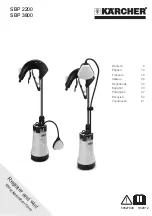
SAFETY
-5-
12. Do not force the machine.
The machine will do a safer and better job at the rate for which it was
designed.
13. Use the correct tool.
Do not force the tool or attachment to do a job for which it was not designed.
14. Wear the proper apparel.
Do not wear loose clothing, neck ties, gloves, jewelry, keep long hair tied
up, etc.
15. Remove all adjusting keys and wrenches.
Before turning the machine on, make it a habit to check
that all adjusting keys and wrenches have been removed.
16. Use proper extension cord.
Examine the extension cord to ensure it is in good condition. Use the
chart below to determine the correct length and gauge of extension cord needed for your particular
needs. The amp rating of the motor can be found on its nameplate. If the motor is dual voltage, be
sure to use the amp rating for the voltage you will be using. If you use an extension cord with an
undersized gauge or one that is too long, excessive heat will be generated within the circuit increas-
ing the chance of a fire or damage to the circuit. Only use an extension cord that has a ground pin.
Immediately replace an extension cord if it shows any signs of damage.
17. Keep your footing stable and keep your balance at all times.
18. Do not leave the machine unattended.
Wait until it comes to a complete stop before leaving the
area.
19. Perform all machine maintenance
and follow all lubrication instructions in this manual.
20. Keep the machine away from open flame.
Operating machines near pilot lights and/or open flames
creates a high risk if dust is dispersed in the area. Dust particles and an ignition source may cause
an explosion. Do not operate the machine in high-risk areas, including but not limited to, those men-
tioned above.
21. If at any time you are experiencing
difficulties performing the intended operation, stop using the
machine! Then contact our service department or ask a qualified expert how the operation should
be performed.
22. Habits—good and bad—are hard to break.
Develop good habits in your shop and safety will become
second-nature to you.
Always wear safety glasses or goggles when
operating equipment. Operating this equip-
ment creates the potential for flying debris
to cause eye injury. Everyday glasses or
reading glasses only have impact resistant
lenses, they are not safety glasses. Be cer-
tain the safety glasses you wear meet the
appropriate standards of the American
National Standards Institute (ANSI).
Length And Gauge
Amp Rating 25ft
50ft
100ft
0-6
#18
#16
#16
7-10
#18
#16
#14
11-12
#16
#16
#14
13-16
#14
#12
#12
17-20
#12
#12
#10
21-30
#10
#10
No
Extension Cord Requirements








































